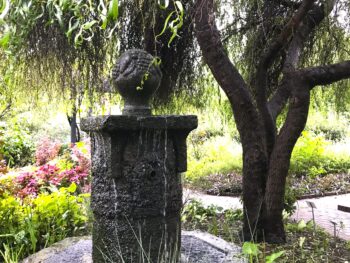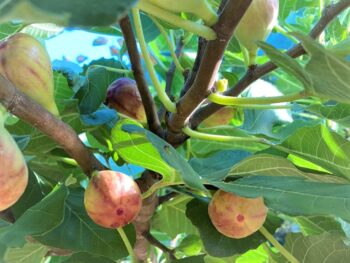Easter lilies are filling up florists and grocers’ floral departments, in anticipation of the glorious celebration ahead! May we take their trumpet shape as a megaphone to our hearts: Listen! Listen to the still, steadfast voice, the Lord’s leading us in his blessing and direction:
“Are you listening, dear people?
Psalm 50:7 The Message
Just then a light-radiant cloud enveloped them, and from deep in the cloud, a voice: “This is my Son, marked by my love. Listen to him.”
Mark 9:7 The Message
The beautiful holiday flowers will fade, but we have His Words forever—the sounding and promise of “flowers of the field.” (Isaiah 40:6-8)
Lilies in the Bible
When it comes to lilies in the Bible, there is a bit of botanical bewilderment, for those of us prone to decipher details, that is! The original English translation of Jesus’ candid words on worry offered “krinon” as lilies, though most Biblical botanists agree that the grassy fields from which his words were spoken are filled with lily-like flowers, those returning from bulbs or tubers after a dormant period, and not actual lilies. Instead, general consensus credits the crown anemone as the blooming scenery of his straightforward talk.
Lilies for Your Garden
 However, there is a lily native to Israel’s woodlands (not fields), the Madonna lily, Lilium candidum, and this species is sold commercially. Mine are on their way from Brent & Becky’s Bulbs! They are similar in appearance to the classic Easter lily, but bloom a little later than Easter and Passover celebrations, into the summer. Their trumpeted, white flowers form clusters on tallish, 3 foot stems, and I plan to plant them just along shadows edge of our shade garden to shelter them from the full, blazing sun of our climate. Height-wise, they make a good visual transition from perennial border to evergreen hedge.
However, there is a lily native to Israel’s woodlands (not fields), the Madonna lily, Lilium candidum, and this species is sold commercially. Mine are on their way from Brent & Becky’s Bulbs! They are similar in appearance to the classic Easter lily, but bloom a little later than Easter and Passover celebrations, into the summer. Their trumpeted, white flowers form clusters on tallish, 3 foot stems, and I plan to plant them just along shadows edge of our shade garden to shelter them from the full, blazing sun of our climate. Height-wise, they make a good visual transition from perennial border to evergreen hedge.
Listen to His Words
Floral conundrums notwithstanding, the point here is that we plant flowers in our gardens and likewise, we can plant the Words of the Lord in our hearts and souls. His voice remains ready to speak to each of us.
Listening is what we do when someone speaks to us; reading is what we do when someone writes to us. Speaking comes first. Writing is derivative from speaking. And if we are to get the full force of the word, God’s Word, we need to recover its atmosphere of spokenness. —Eugene H. Peterson, Eat This Book, 2006
May “considering the lilies” lead to our listening, and flourish our faith in His Words.
He wants you to listen to him! Plain listening is the thing, not staging a lavish religious production.
1 Samuel 15:22 The Message
Pay attention, come close now, listen carefully to my life-giving, life-nourishing words.
Isaiah 55:3 The Message
She had a sister called Mary, who sat at the Lord’s feet listening to what he said.
Luke 10:39 NIV
After all this, God tested Abraham. God said, “Abraham!” “Yes?” answered Abraham. “I’m listening.”
Genesis 22:1 The Message
Listen, everyone, listen— earth-dwellers, don’t miss this. All you haves and have-nots, All together now: listen.
Psalm 49:1-2 The Message
And the sheep listen to the voice of the shepherd.
John 10:3 ERV
Listen obediently, Israel. Do what you’re told so that you’ll have a good life, a life of abundance and bounty, just as God promised, in a land abounding in milk and honey.
Deuteronomy 6:3 The Message
Before you trust, you have to listen.
Romans 10:17 The Message
 Let Faith Flourish! is a Lenten series on “flowers of the field”— crown anemones, chamomile, tulips, lilies, narcissus, and poppies. In these flower-filled weeks ahead, as our landscapes wake up in spring’s gentle warming and fill with bloom and blossom, may worry be displaced with the Word of the Lord. May the true flourish of the Lenten season be in our faith!
Let Faith Flourish! is a Lenten series on “flowers of the field”— crown anemones, chamomile, tulips, lilies, narcissus, and poppies. In these flower-filled weeks ahead, as our landscapes wake up in spring’s gentle warming and fill with bloom and blossom, may worry be displaced with the Word of the Lord. May the true flourish of the Lenten season be in our faith!
For more on lilies in the Bible, see “En Gedi, Lay of the Land,” in God’s Word for Gardeners Bible, page 270
See more of the Madonna or white lily at www.flowersinisrael.com/Liliumcandidum_page.htm
To order Lilium candium from Brent & Becky’s Bulbs, go to www.brentandbeckysbulbs.com/Lilium/candidum/Lily
Photo Credits:
©2013 Maja Dumat, Madonnenlilie (Lilium candidum) from Flickr Creative Commons
©2015 Zachi Evenor Shoshan-Zachi-Evenor-6975 Lilium candidum, Wadi Kelach, Mount Carmel, Israel Flickr Creative Commons














